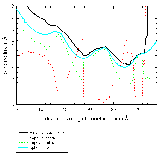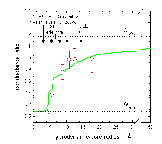









An examination of the pore dimensions of the crystal structure for the cholera toxin B subunit pentamer was conducted using HOLE. It has been suggested that the A-subunit which must translocate through the membrane as part of its mode of toxicity may do so by passing through the channel formed by the B subunit pentamer21 . However, it has been noted that the pore found in the crystal structures is not sufficiently large to allow such a motion23 and that there may be some rearrangement of the pentamer on incorporation into the membrane. It is therefore interesting to examine whether the crystal structure is compatible with the conductance data available - if it is then such a rearrangement may be excluded.
The structure examined is the 2.2Å resolution structure
solved by Merritt et al.19:

If you have configured your browser to use rasmol then try using this link to the pdb file to interactively view the structure.
The pore dimensions of the channel as calculated by HOLE show a pore which is sufficiently large to be accommodate two water molecules side by side at any place within the channel.

This can also be seen by plotting a graph of pore radius versus distance
along the channel coordinate:

Comparison of the minimum effective pore radius found with that of the porin family is instructive:
| System | Minimum effective radius in Å |
| E. coli porin Ompf15 | 3.90 |
| E. coli phosphoporin 1PhoE15 | 3.39 |
| E. coli maltoporin18 | 2.85 |
| cholera toxin B519 | 3.24 |
This begs the question; is there a possibility of a conformational rearrangement of the B pentamer, with a widening of the pore, on incorporation into a lipid bilayer as postulated by Zhang23? If the HOLE prediction of the conductance of the crystal structure was significantly smaller than the experimentally found conductance this would be indicative of such a change. In fact the predicted conductance is consistent with the experimental value 11 so it would appear that a conformational rearrangement is unlikely. This conclusion is further strengthened by comparing the prediction for the expected profile of a PEG addition experiment with that found:

It can be seen that according to the HOLE calculation the crystal structure is in fact compatible with the effect on conductance data. Thus the possibility of a significant conformational arrangement accompanying the incorporation of cholera toxin B5 can be seen to be unlikely. This does not necessarily mean that the proposed translocation of the A-subunit through the B pentamer does not occur, only that such a motion would involve a considerable alteration to the structure of either or both the A-subunit and the B pentamer.





Oliver S. Smart (last modified 20/12/96)